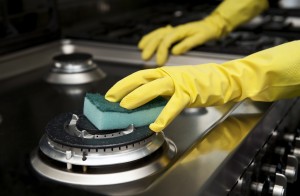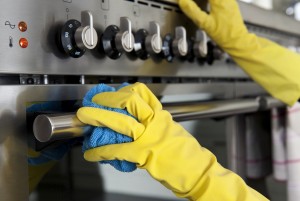
Ovens
Maintaining an oven includes regular cleaning for it to operate optimally. Like many appliances there are different types of ovens that fulfill various functions. To keep the oven running optimally one must know how it operates in regard to the unique functional features the appliance possesses. For example, ovens come in gas or electric models, self cleaning, or continuously cleaning. Developing a working knowledge of the oven’s functional capabilities and how it operates will make regular cleaning hassle free.
How To
Certain oven models will require virtually no effort except the push of a button, and are typically self-cleaning electric ovens. The intense heat of the clean turns food buildup into pure carbon through complete combustion. The end result requires that one simply sweep up the remaining dust with a damp sponge after the oven cools. Other models will require one to dig deep and use some elbow grease to remove buildup. Removing buildup on a non self-cleaning oven will generally require an oven-cleaning spray to break up burnt grease which can then be wiped away with a damp cloth or sponge. Easy Off is a popular brand which sells products to do just that. For a more natural clean, oven cleaner can be made by mixing ¾ cups of baking soda ¼ cup of salt and ¼ cup of water into a paste. This can then be spread inside the oven to sit before wiping clean. It is important to be aware that using a commercial oven cleaner on a self-cleaning oven can compromise the structural integrity of your  appliance.
appliance.
Typically oven cleaner on non-self cleaning models can be applied for 30 minutes or overnight before cleaning. Since ovens come in both gas and electric models, there are different structures to clean that fulfill the ovens respective function. Electric ovens have two heating elements in which the bottom element can usually be lifted for ease of access. In general, the door of an even can unhinge to permit full access to the oven’s interior. Cleaning a gas oven is slightly more intensive since the bottom requires the most work. The bottom is also where the gas burner is located, which needs to be kept debris free. A coat hanger can be inserted into the burner to unclog the gas ports. One can then check to see if the burner is running efficiently by examining the flame and referring to their owner’s manual. Continuous self cleaning ovens have a unique lining that gradually burn off spills as the oven is used, and take relatively little effort to clean. For a continuous cleaning oven it is best to wipe up spills as soon as the appliance cools-especially for starchy or sugary foods.
Tips & Takeaways
Regularly cleaning an oven is necessary for its safe operation. It is important to remove the racks and dig deep for a thorough clean of the oven’s interior. Old food spills and baked on grease are prone to catch fire when the oven is in use. On self cleaning ovens it is important to lock the oven door during the process, ensuring that the oven has cooled before wiping up any ash inside. In general, tough stains and large chunks of food can be scraped off using a plastic spatula.

For localized spills, buildup, and baked on grease, spot cleaning is typically the best method for removal. There are a wide variety of oven cleaners which generally serve the same purpose, some of which can be used safely on self-cleaning ovens. Easy- Off has a popular line of products tailored towards an oven’s unique functional capabilities, which include products that are safe when using both the traditional method and on self-cleaning ovens. Furthermore, Easy-Off promotes their products as a simple “spray and wipe” system which works quick and effectively.